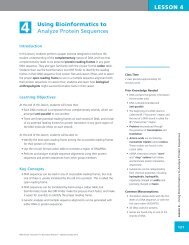WET LAB DNA Barcoding: From Samples to Sequences - Northwest ...
WET LAB DNA Barcoding: From Samples to Sequences - Northwest ...
WET LAB DNA Barcoding: From Samples to Sequences - Northwest ...
Create successful ePaper yourself
Turn your PDF publications into a flip-book with our unique Google optimized e-Paper software.
<strong>WET</strong> <strong>LAB</strong><br />
e. Deoxynucleotides (dNTPs) and dideoxynucleotides (ddNTPs): Just like<br />
in your cells, dNTPs are the building blocks of the new <strong>DNA</strong> molecules, but<br />
with <strong>DNA</strong> sequencing, some of the dNTPs are missing an –OH group (ddNTPs),<br />
so the <strong>DNA</strong> molecule cannot elongate further. This results in many <strong>DNA</strong><br />
fragments of different sizes (each differing in size by one <strong>DNA</strong> base), as seen<br />
in Parts A, B, and C in Slide #23. The ddNTPs also contain a fluorescent tag:<br />
thymine is red, adenine is green, cy<strong>to</strong>sine is blue, and guanine is black (shown<br />
in Slide #23 as purple, Part C). The <strong>DNA</strong> sequencing machine runs a tiny gel,<br />
separating each <strong>DNA</strong> fragment by size, reading the color of the fluorescent<br />
tag, and translating those colors in<strong>to</strong> a <strong>DNA</strong> sequence (shown in Slide #23 as<br />
Part D). The data output from this progress is called a chroma<strong>to</strong>gram.<br />
Dideoxyribonucleotide triphosphates<br />
(ddNTPs): Dideoxyribonucleotide<br />
triphosphates (abbreviated<br />
ddNTPs) are similar <strong>to</strong> the normal<br />
deoxyribonucleotide triphosphates<br />
that are used for making <strong>DNA</strong> with one<br />
change: they are missing the 3’ hydroxyl<br />
(-OH) group on the deoxyribose<br />
sugar.<br />
Wet Lab: Slide #23<br />
Chroma<strong>to</strong>gram: A chroma<strong>to</strong>gram is<br />
a type of data file produced by a <strong>DNA</strong><br />
sequencing instrument.<br />
39. Finally, show students Slide #24, “PCR Purification,” and explain <strong>to</strong><br />
them that because <strong>DNA</strong> sequencing is so similar <strong>to</strong> the PCR experiment<br />
they performed, they must remove all of their PCR ingredients before<br />
sending samples for sequencing. To do this, they perform a PCR<br />
purification, which is very similar <strong>to</strong> <strong>DNA</strong> purification, but with fewer<br />
steps, as there are no cells <strong>to</strong> break open!<br />
• Step 1: Mix the <strong>DNA</strong> (PCR product) with <strong>DNA</strong> binding buffer.<br />
• Step 2: Bind the <strong>DNA</strong> <strong>to</strong> the spin column and wash away the PCR ingredients.<br />
• Step 3: Elute the <strong>DNA</strong> off the spin column.<br />
Wet Lab: Slide #24<br />
Wet Lab – <strong>DNA</strong> <strong>Barcoding</strong>: <strong>From</strong> <strong>Samples</strong> <strong>to</strong> <strong>Sequences</strong><br />
343<br />
©<strong>Northwest</strong> Association for Biomedical Research—Updated Oc<strong>to</strong>ber 2012
















